The Chiaravalle Cross: Results of a Multidisciplinary Study
Abstract
1. Introduction
2. Materials and Methods
2.1. Radiocarbon Dating
2.2. Gemological Study
2.3. Scanning Electron Microscope (SEM) Measurements
3. Results
3.1. Radiocarbon Dating Results
| Code | pMC | tRC (years BP) | Calibrated Date (±1σ) | Calibrated Date (±2σ) |
| RC439 | 97.10 ± 0.36 | 236 ± 30 | 1645–1800 AD | 1530–present |
| RC442 | 90.28 ± 0.34 | 822 ± 30 | 1190–1260 AD | 1165–1265 AD |
| RC443 | 89.51 ± 0.34 | 890 ± 30 | 1050–1205 AD | 1040–1220 AD |
3.2. Gemstones Characterization
3.3. SEM Results
4. Discussion
Author Contributions
Funding
Acknowledgments
Conflicts of Interest
References
- Bertelli, C. Tesori d’Arte Restaurati, a Cura di Carlo Bertelli e Giorgio Bonsanti. Restituzioni. 2016. Available online: http://www.restituzioni.com/opere/croce-di-chiaravalle/ (accessed on 26 July 2019).
- Catalogus Monachorum Cistercensum Lombardiae; Ms. AE.XV, 15, fol 259r; Biblioteca Braidense: Milano, Italy, 17th Century.
- Giulini, C. Memorie Spettanti allo Stato, al Governo e alla Descrizione della Città e della Campagna di Milano; Colombo: Milano, Italy, 1760; pp. 1854–1857. [Google Scholar]
- Fumagalli, A. Delle Antichità Longobardico-Milanesi Illustrate con Dissertazioni dei Monaci Cisterciensi di Lombardia; Nell’imperial Monistero di S; Ambrogio Maggiore: Milano, Italy, 1793; Volume IV. [Google Scholar]
- Caffi, M. Dell’abbazia di Chiaravalle in Lombardia. Illustrazione Storico-Monumentale-Epigrafica; Giacomo Gnocchi: Milano, Italy, 1842. [Google Scholar]
- Caselli, L. La Croce di Chiaravalle Milanese e le Croci Veneziane in Cristallo di Rocca; Il Prato Edizioni: Padova, Italy, 2002; ISBN 978-8887243505. [Google Scholar]
- Benati, G.; Di Martino, D. La Croce di Chiaravalle. Approfondimenti Storico-Scientifici in Occasione del Restauro. Atti del Convegno, Milano 2016; Booktime: Milano, Italy, 2017; ISBN 9788862182935. [Google Scholar]
- Di Martino, D.; Perelli Cippo, E.; Gorini, G. From tiny gold filigrees to majestic iron tie rods: Neutron facilities for the benefit of cultural heritage. Eur. Phys. J. Plus 2018, 133, 371. [Google Scholar] [CrossRef]
- Di Martino, D.; Cippo, E.P.; Scherillo, A.; Kasztovszky, Z.; Harsányi, I.; Kovács, I.; Szokefalvi-Nagy, Z.; Cattaneo, R.; Gorini, G. An Archaeometallurgical Investigation on Metal Samples from the Chiaravalle Cross. Heritage 2019, 2, 836–847. [Google Scholar] [CrossRef]
- Di Martino, D.; Cucini, C.; Gagetti, E.; Riccardi, M.P. The golden filigree of the Chiaravalle Cross: Further insights from a PIXE/PIGE study. In Proceedings of the IBA 2019 Conference, Antibes, France, 13–18 October 2019. in preparation. [Google Scholar]
- Reimer, P.J. Intcal13 and Marine13 Radiocarbon Age Calibration Curves 0–50,000 Years Cal Bp. Radiocarbon 2013, 55, 1869–1887. [Google Scholar] [CrossRef]
- Anderson, B.W. Gem Testing; Butterworths: Oxford, UK, 1985. [Google Scholar]
- XGLab Company, Details. Available online: https://www.xglab.it/combined-xrf-spectrometer-raman-analyzer-xraman.shtml (accessed on 26 July 2019).
- Schmidt, P.; Bellot-Gurlet, L.; Lea, V.; Sciau, P. Moganite detection in silica rocks using Raman and infrared spectroscopy. Eur. J. Mineral. 2013, 25, 797–805. [Google Scholar] [CrossRef]
- Shubnel, H.J. La Microsonde Raman en La Gemologie, Association Francaise de Gemmologie; Revue de Gemmologie a.f.g., n. de Commission Paritaire 59739: Paris, France, 1992. [Google Scholar]
- Schmidt, C.M.; Walton, M.S.; Trentelman, K. Characterization of Lapis Lazuli Pigments Using a Multitechnique Analytical Approach: Implications for Identification and Geological Provenancing. Anal. Chem. 2009, 81, 8513–8518. [Google Scholar] [CrossRef] [PubMed]
- Gliozzo, E.; Grassi, N.; Bonanni, P.; Meneghini, C.; Tomei, M.A. Gemstones from Vigna Barberini at the Palatine Hill (Rome, Italy). Archaeometry 2011, 53, 469–489. [Google Scholar] [CrossRef]
- Greggio, L.; Musa, M.; D’Amico, F.; Gori, L.; Passera, E.; Tagliapietra, R.; Croce, A.; Rinaudo, C. Natural and enhanced colours in natural and synthetic corundum. Is it always possible to detect them? Presented at the SGI-SIMP Italian GeoSciences 2014 Congress, Milan, Italy, 10–12 September 2014. [Google Scholar]
- Deer, W.A.; Howie, R.A.; Zussman, J. An Introduction to the Rock-Forming Minerals, 2nd ed.; Zanichelli: Rome, Italy, 1992. [Google Scholar]
- Gubelin, E.J.; Koivula, J.I. Photoatlas of Inclusions in Gemstones; Opinio Verlag: Basel, Switzerland, 1997. [Google Scholar]
- Rinaudo, C.; Croce, A.; Musa, M.; Fornero, E.; Allegrina, M.; Trivero, P.; Bellis, D.; Sferch, D.; Toffalorio, F.; Veronesi, G.; et al. Study of inorganic particles fibers, and asbestos bodies by variable pressure scanning electron microscopy with annexed energy dispersive spectroscopy and micro-Raman spectroscopy in thin sections of lung and pleural plaque. Appl. Spectrosc. 2010, 64, 571–577. [Google Scholar] [CrossRef] [PubMed]
- Giumlia Mair, A.; Merini, S.; Lucchini, E. Indagini archeometallurgiche su dorature antiche: Analisi, tecniche e variant. In I Bronzi Antichi: Produzione e Tecnologia Atti del XV Congresso Internazionale sui Bronzi antichi. Gorizia; Mergoil, M., Ed.; Monographies Instrumentum: Dremil-Lafage, France, 2001; pp. 338–343. ISBN 978-2907303637. [Google Scholar]
- Schmetzer, K.; Hanni, H.A.; Bernhardt, H.; Schwarz, D. Trapiche Rubies. Gems Gemol. 1996, 32, 242–250. [Google Scholar] [CrossRef]
- Schmetzer, K.; Beili, Z.; Yan, G.; Bernhardt, H.; Hanni, H.A. Element Mapping of Trapiche Rubies, gemmological association and Gem Testing Laboratory of Great Britain. J. Gemm. 1998, 26, 289–301. [Google Scholar] [CrossRef]
- Garnier, V.; Ohnenstetter, D.; Giuliani, G.; Blanc, P.; Schawarz, D. Trace-Element Contents and Cathodoluminescence of “Trapiche” Rubies from MongHsue, Myanmar (Burma): Geological Significance. Mineral. Petrol. 2002, 76, 179–193. [Google Scholar] [CrossRef]
- Sena Chiesa, G. Gemme Dalla Corte Imperiale alla Corte Celeste; Hoepli: Milano, Italy, 2002; ISBN 8820330873. [Google Scholar]
- Gagetti, E. Le remploi d’objets paiens dans les objets liturgiques chrétiens. In Le Camée de Nancy de Néron à saint Nicolas; Lenoir, J., Ed.; Bibliothèques de Nancy: Nancy, France, 2018; pp. 74–99. ISBN 9782951563490. [Google Scholar]
- Webster, R. Gems, Their Sources, Description and Identification, IV ed.; Anderson, B.W., Ed.; Elsevier Science & Technology Books: Amsterdam, The Netherlands, 1983. [Google Scholar]
- Greggio, L.; Musa, M. Advanced Seminar: Color Gemstone Identification; Gemmological Education and Certification Institute: Milano, Italy, 2016. [Google Scholar]
- Li, R.K. Stone Beads and their Imitations. BEADS J. Soc. Bead Res. 1998, 10–11, 13–18. [Google Scholar]
- Lazzarini, L. I diaspri siciliani: Genesi, composizione e storia di alcune tra le pietre più usate dall’Opificio fiorentino. In Pietre Colorate Molto Vaghe e Belle; Arte Senza Tempo dal Museo dell’Opificio delle Pietre Dure; Rossi, S., Assmann, P., Patera, A., Gennaioli, R., Eds.; Tre lune Edizioni: Mantova, Italy, 2018; pp. 85–107. [Google Scholar]
- Jackson, C.M. Making colourless glass in the roman period. Archaeometry 2005, 47, 763–780. [Google Scholar] [CrossRef]
- Mannoni, T.; Giannichedda, E. Archeologia Delle Produzione; Einaudi: Torino, Italy, 1996. [Google Scholar]
- Garzya Romano, C. Book Eraclio. I Colori e le Arti dei Romani (e la Compilazione Pseudo-Eracliana); Il Mulino: Bologna, Italy, 1996; ISBN 978-88-15-05533-0. [Google Scholar]
- Doctrina poliendi, planandi, secandi, sculpendi et perforandi pretiosos lapides. Londra British Library Add. 41486 c.45r; British Museum Catalogue of Additions to the Manuscripts 1926–1930, London; 1959; pp. 42–52.
- Ferretti, M.; Polese, C.; García, C.R. X-ray fluorescence investigation of gilded and enamelled silver: The case study of four medieval processional crosses from central Italy. Spectrochim. Acta B 2013, 83–84, 21–27. [Google Scholar] [CrossRef]
- Ager, F.J.; Ferretti, M.; Grilli, M.L.; Juanes, D.; Ortega-Feliu, I.; Respaldiza, M.A.; Roldán, C.; Scrivano, S. Reconsidering the accuracy of X-ray fluorescence and ion beam based methods when used to measure the thickness of ancient gildings. Spectrochim. Acta B 2017, 135, 42–47. [Google Scholar] [CrossRef]
| 1 | |
| 2 | |
| 3 |
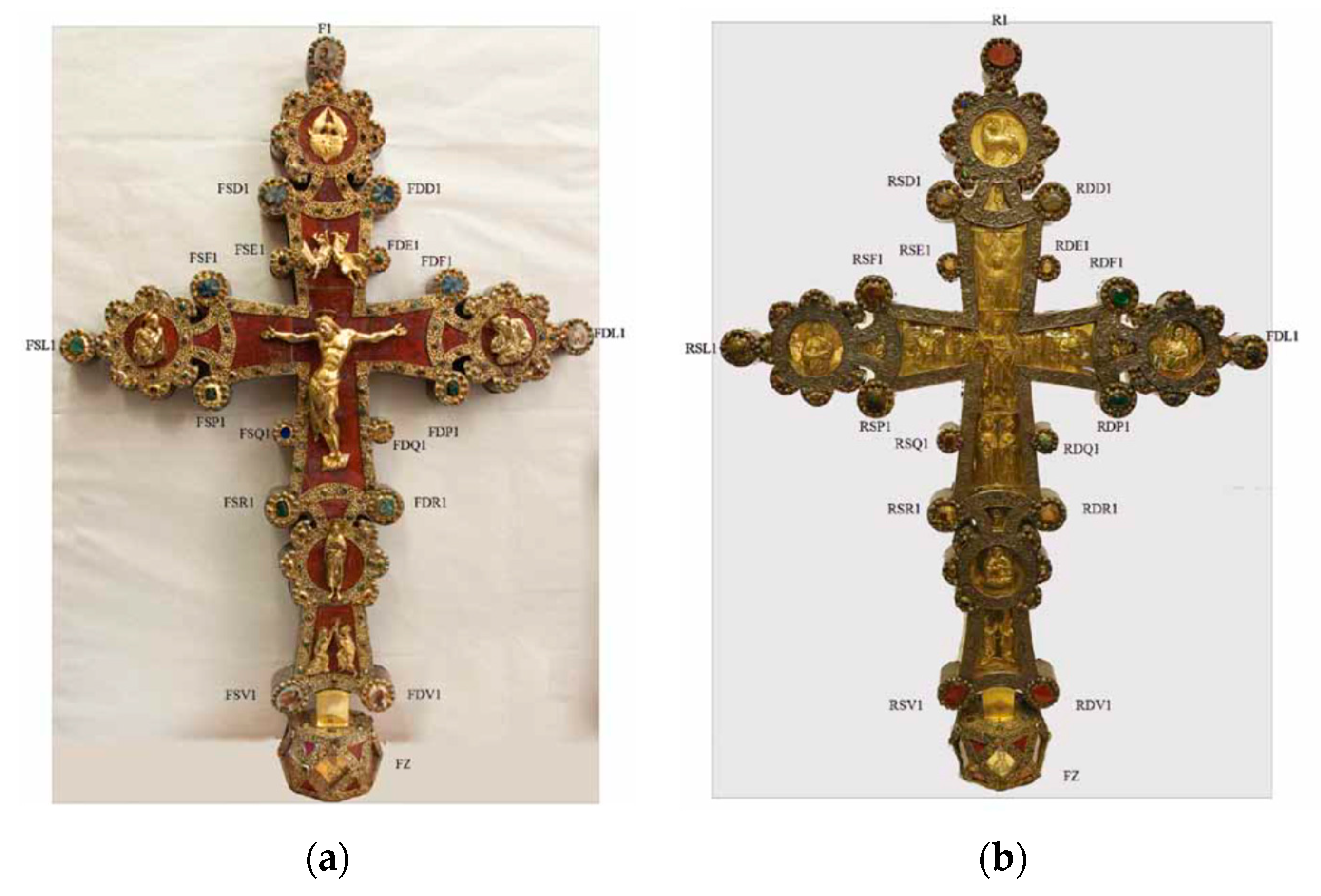

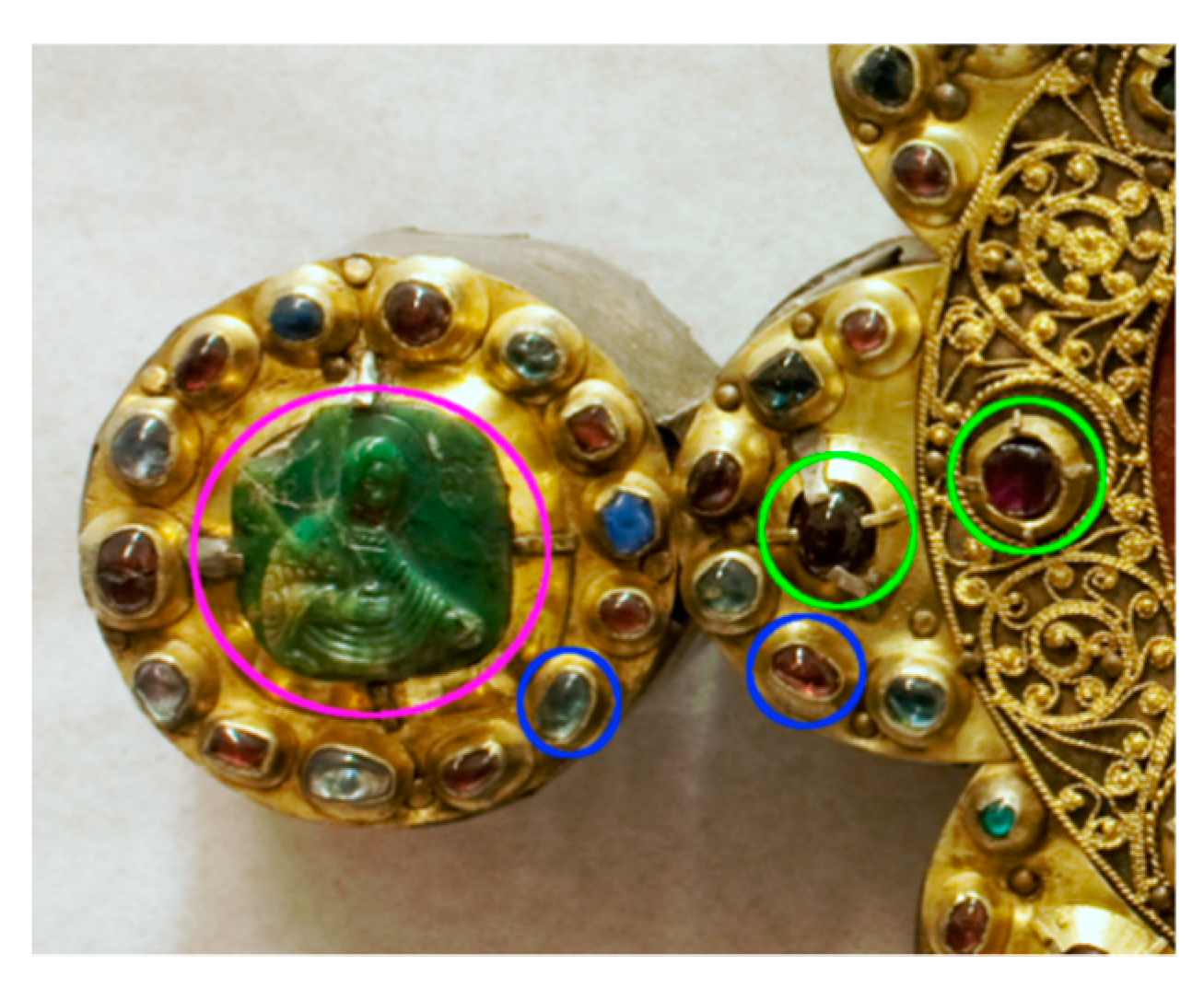
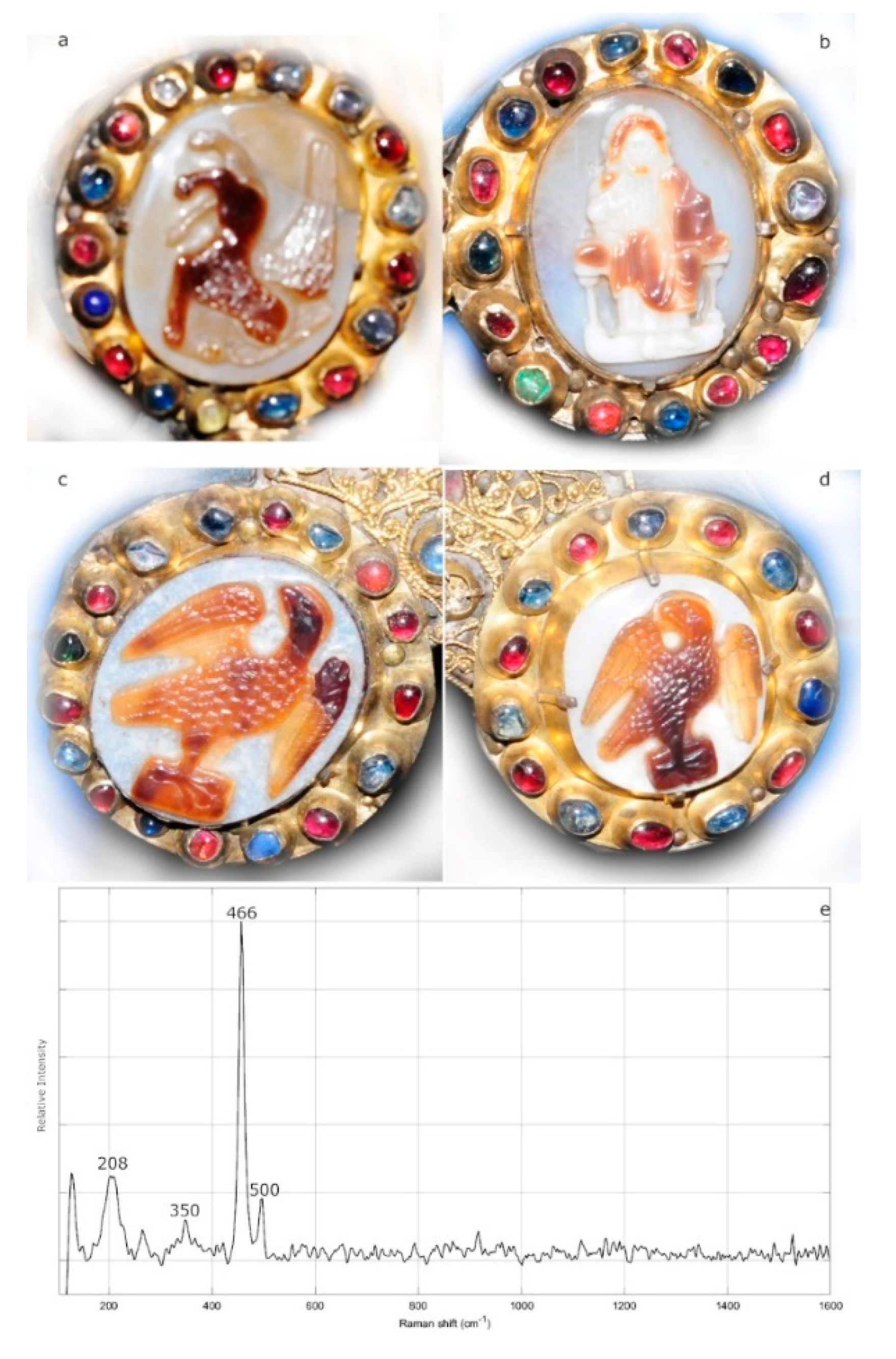
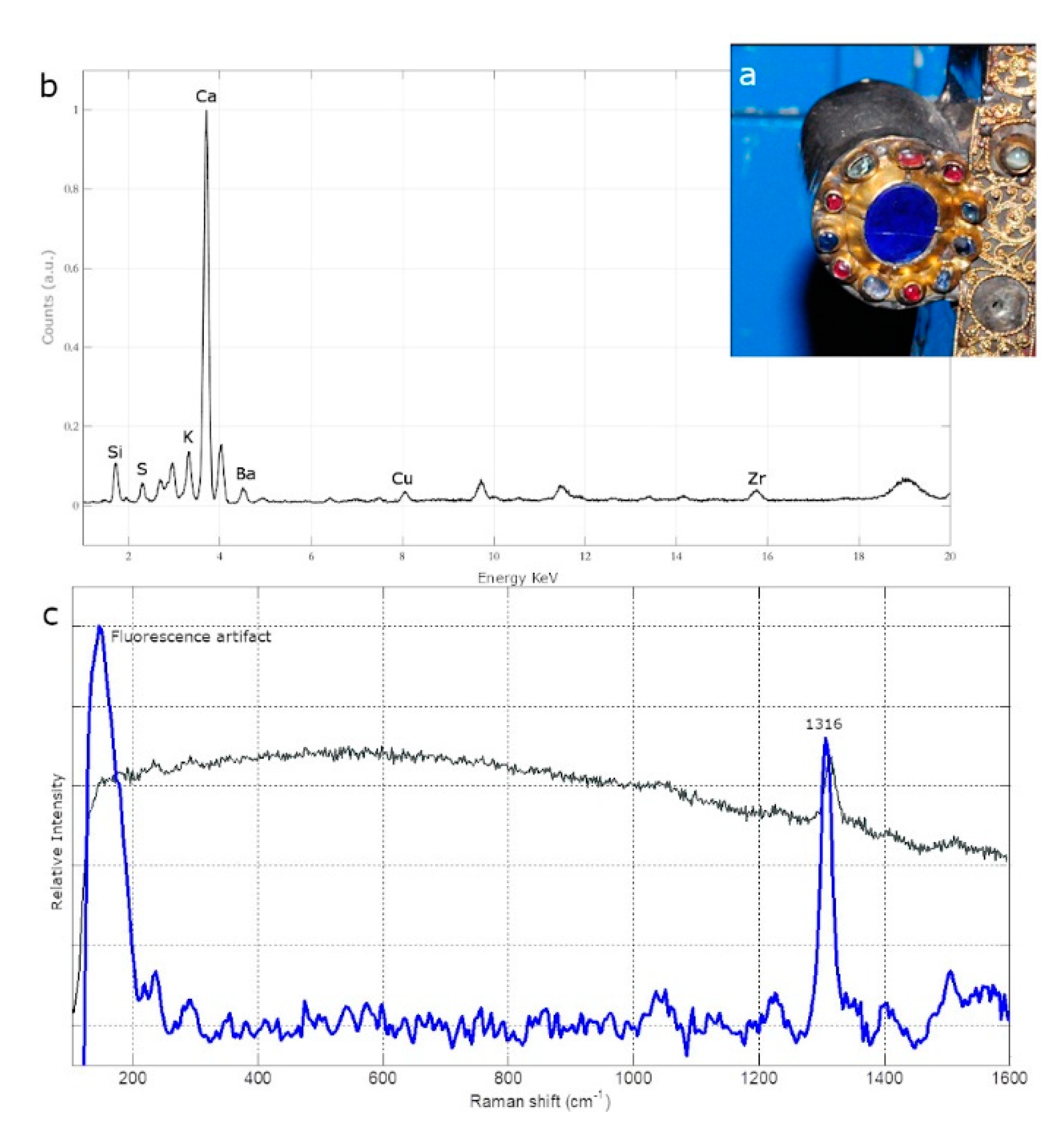
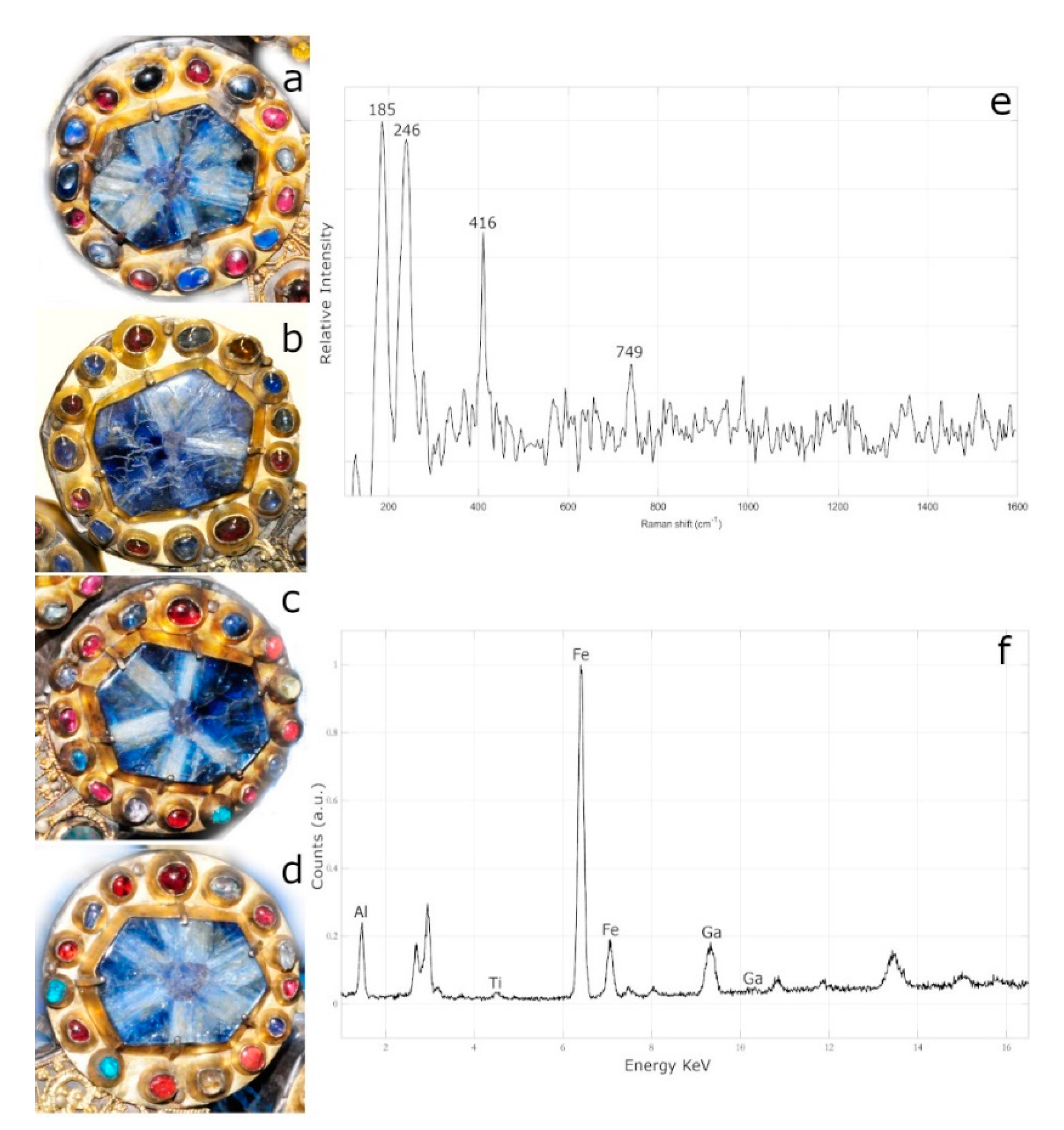
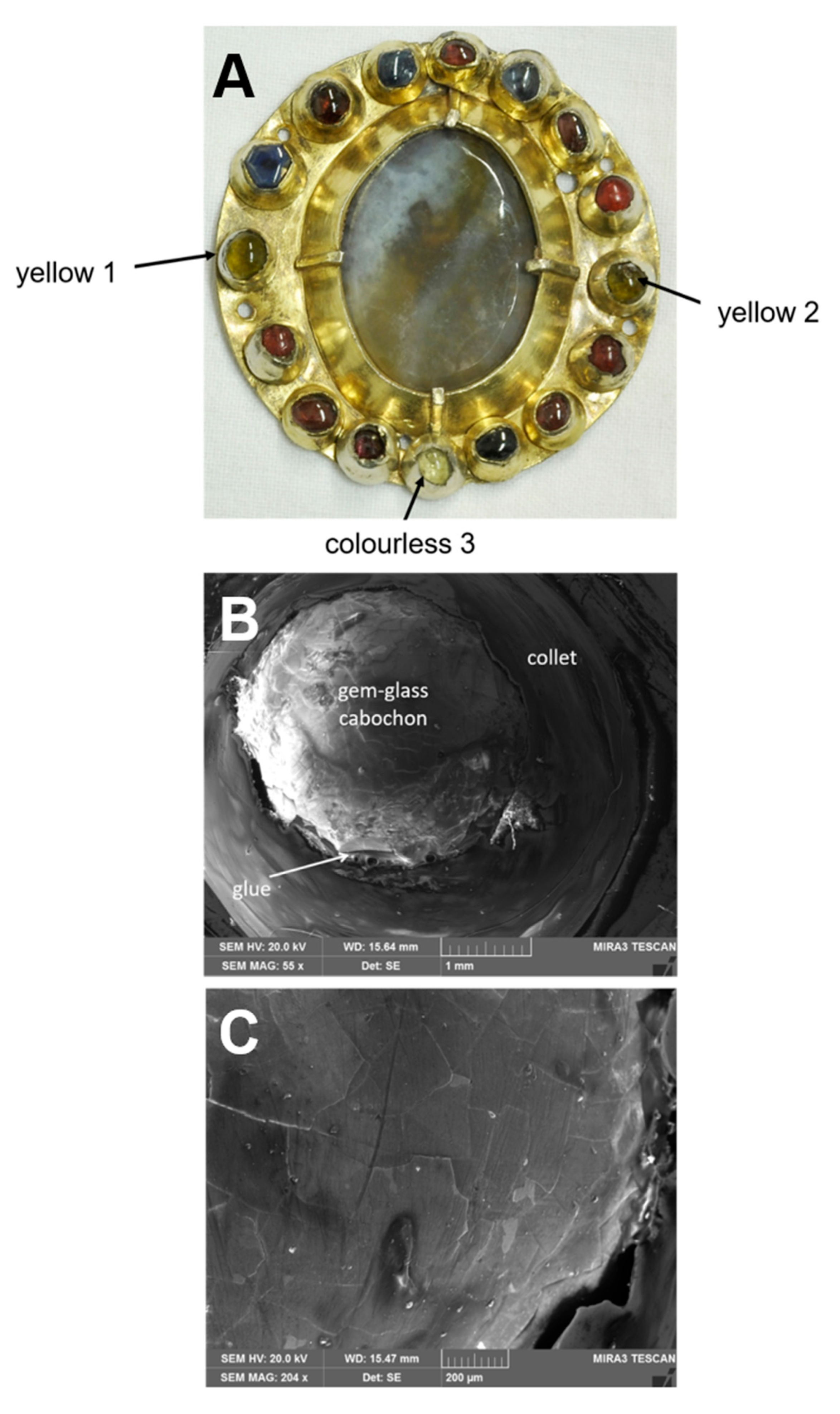
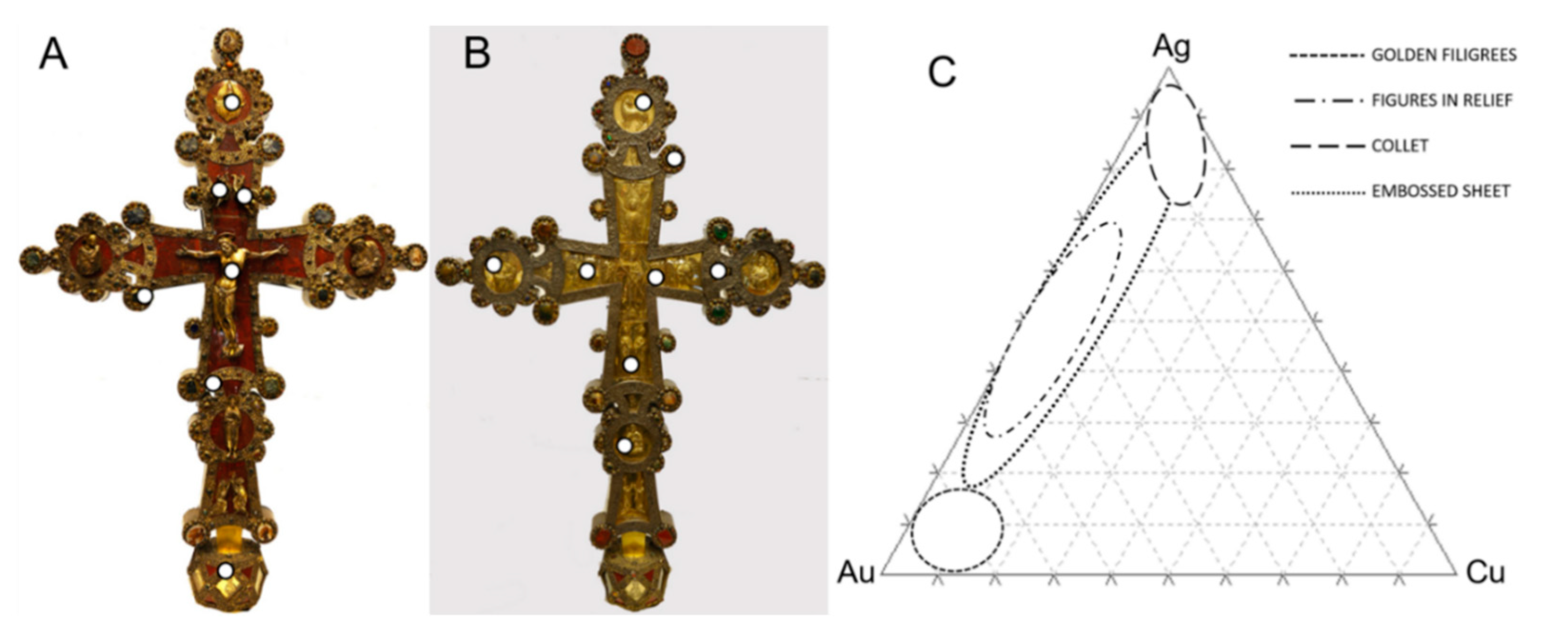

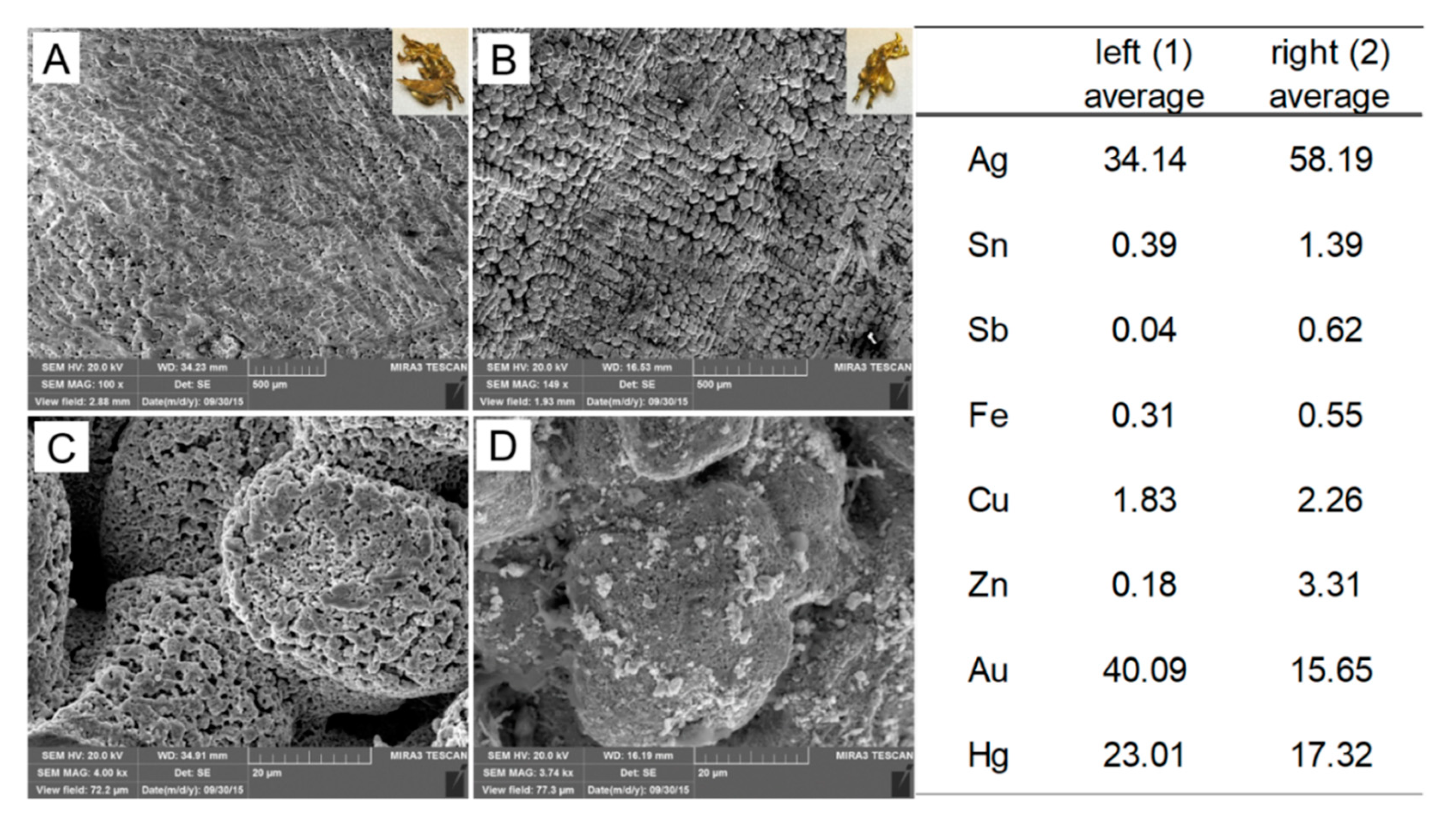
| Front | Rear |
|---|---|
| 420 lateral gemstones (0.40–0.60 ct 1) | 420 lateral gemstones (0.40–0.60 ct 1) |
| 96 central gemstones (1.00–3.00 ct 1) | 15 central gemstones (0.80–3.00 ct 1) |
| (a) FRONT | |||
| Red | Blue | Green–Yellow–Other | |
| LATERAL | mainly garnets and spinels; rare rubies | mainly sapphires; rare iolite and moonstones 1, artificial glass | beryls, few emeralds included, tiger eye quartz 1, artificial glass |
| CENTRAL | mainly rubies | sapphires, few lapis, rare artificial glass | artificial glass, amethysts and chalcedonies |
| (b) REAR | |||
| Red | Blue | Green–Yellow–Other | |
| LATERAL | mainly garnets and spinels; rare rubies | mainly sapphires; rear iolite and moonstones 1 artificial glass | green beryls and few emeralds, tiger eye quartz 1, artificial glass |
| CENTRAL | rubies and spinels | sapphires and artificial glass | artificial glass, amethysts and moonstones1 |
| Code | Dimensions (mm) | Shape and Cut | Transparency | Color | Identification |
|---|---|---|---|---|---|
| F1 | 35.7 × 29.3 × 2.8 | oval cameo | translucent | brown and white | chalcedony, sardonyx variety |
| FDD1 | 32.4 × 23.5 × 2.4 | hexagonal tablet | translucent | blue and white | trapiche sapphire |
| FDE1 | 15.8 × 12.4 × 2.7 | irregular cabochon | translucent | green | artificial glass |
| FDF1 | 30.5 × 21.7 × 2.8 | hexagonal tablet | translucent | blue and white | trapiche sapphire |
| FDL1 | 33.1 × 25.6 × NA | oval cameo | opaque | brown and white | chalcedony, sardonyx variety |
| FDP1 | 20.6 × 16.7 × NA | cushion cameo | translucent | brownish green | artificial glass |
| FDQ1 | 17.0 × 15.8 × 2.3 | oval tablet | opaque | orangy brown | Artificial mixture |
| FDR1 | NA | square cameo | translucent | greenish blue | chalcedony |
| FDV1 | 27.6 × 24.0 × NA | cameo | translucent | brown and white | chalcedony, sardonyx variety |
| FSV1 | 36.6 × 30.0 × 4.4 | cameo | translucent | brown and white | chalcedony, sardonyx variety |
| FSR1 | 22.8 × 14.8 × 3.4 | oval cameo | translucent | green | artificial glass |
| FSQ1 | 15.4 × 13.7 × NA | oval tablet | opaque | blue | lapis simulant |
| FSP1 | NA | oval cameo | translucent | brownish green | artificial glass |
| FSL1 | NA | cameo | opaque | bluish green | artificial glass |
| FSF1 | NA | hexagonal tablet | translucent | blue and white | trapiche sapphire |
| FSE1 | 15.0 × 11.5 × 2.5 | irregular cabochon | translucent | green | artificial glass |
| FSD1 | 31.9 × 23.3 × 2.7 | hexagonal tablet | translucent | blue and white | trapiche sapphire |
| R1 | 32.8 × 27.4 × 2.1 | oval tablet | opaque | red | jasper |
| RDD1 | 29.3 × 18.6 × 7.2 | irregular cabochon | translucent | white | chalcedony, agata variety |
| RDE1 | 13.4 × 11.1 × 4.3 | irregular tablet | opaque | orangy brown | jasper |
| RDF1 | 26.0 × 23.7 × 3.0 | irregular cabochon | transparent | green | artificial glass |
| RDL1 | 19.2 × 17.2 × 4.0 | cushion cameo | translucent | green and brown | artificial glass plus greek tar |
| RDP1 | 24.6 × 17.8 × 4.2 | oval cabochon | transparent | green | artificial glass |
| RDQ1 | 17.3 × 14.1 × 4.8 | tumbled | opaque | green and white | chalcedony, plasma variety |
| RDR1 | 19.9 × 14.7 × 3.3 | irregular cabochon | translucent | orangy white | chalcedony |
| RDV1 | 27.8 × 23.3 × 4.1 | rectangular cabochon | opaque | brownish red | jasper |
| RSV1 | 33.7 × 25.0 × 5.0 | oval tablet | opaque | red | jasper |
| RSR1 | 13.0 × 12.5 × 3.5 | oval tablet | opaque | brown and white | chalcedony/jasper |
| RSQ1 | 14.8 × 13.3 × 4.1 | round tablet | opaque | brown | jasper |
| RSP1 | 24.7 × 20.4 × 6.4 | cushion cabochon | opaque | green and brown | jasper |
| RSL1 | 20.9 × 17.3 × 6.2 | irregular triangular cabochon | opaque | brownish green | chalcedony-jasper |
| RSF1 | 25.2 × 23.5 × 4.3 | oval tablet | opaque | brown | chalcedony-jasper |
| RSE1 | 13.0 × 11.5 × 4.2 | irregular tablet | opaque | orangy brown | jasper |
| RSD1 | 22.1 × 14.4 × 6.3 | irregular cabochon | translucent | white | chalcedony, agata variety |
| Colourless 3 | Yellow 2 | Yellow 1 | |
|---|---|---|---|
| Na2O | 1.4 | 1.3 | 1.5 |
| MgO | 3.4 | 3.3 | 3.9 |
| Al2O3 | 0.8 | 0.6 | 0.6 |
| SiO2 | 64.7 | 64.9 | 64.0 |
| P2O5 | 0.7 | 0.9 | 1.2 |
| PbO | 17.7 | 18.6 | 19.2 |
| Cl2O | 0.7 | 0.6 | 0.6 |
| K2O | 6.1 | 6.1 | 5.8 |
| CaO | 3.2 | 2.9 | 2.5 |
| MnO | 0.2 | 0.1 | 0.0 |
| FeO | 0.6 | 0.4 | 0.2 |
| CuO | 0.6 | 0.4 | 0.4 |
© 2019 by the authors. Licensee MDPI, Basel, Switzerland. This article is an open access article distributed under the terms and conditions of the Creative Commons Attribution (CC BY) license (http://creativecommons.org/licenses/by/4.0/).
Share and Cite
Di Martino, D.; Benati, G.; Alberti, R.; Baroni, S.; Bertelli, C.; Blumer, F.; Caselli, L.; Cattaneo, R.; Cucini, C.; D’Amico, F.; et al. The Chiaravalle Cross: Results of a Multidisciplinary Study. Heritage 2019, 2, 2555-2572. https://doi.org/10.3390/heritage2030157
Di Martino D, Benati G, Alberti R, Baroni S, Bertelli C, Blumer F, Caselli L, Cattaneo R, Cucini C, D’Amico F, et al. The Chiaravalle Cross: Results of a Multidisciplinary Study. Heritage. 2019; 2(3):2555-2572. https://doi.org/10.3390/heritage2030157
Chicago/Turabian StyleDi Martino, Daniela, Giulia Benati, Roberto Alberti, Sandro Baroni, Carlo Bertelli, Franco Blumer, Letizia Caselli, Roberta Cattaneo, Costanza Cucini, Fabio D’Amico, and et al. 2019. "The Chiaravalle Cross: Results of a Multidisciplinary Study" Heritage 2, no. 3: 2555-2572. https://doi.org/10.3390/heritage2030157
APA StyleDi Martino, D., Benati, G., Alberti, R., Baroni, S., Bertelli, C., Blumer, F., Caselli, L., Cattaneo, R., Cucini, C., D’Amico, F., Frizzi, T., Gagetti, E., Gironda, M., Greggio, L., Lazzarini, L., Musa, M., Perelli Cippo, E., Riccardi, M. P., & Gorini, G. (2019). The Chiaravalle Cross: Results of a Multidisciplinary Study. Heritage, 2(3), 2555-2572. https://doi.org/10.3390/heritage2030157








